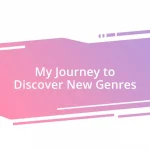Key takeaways:
- Collaboration enriches the creative process by blending diverse ideas and perspectives, enhancing the overall musical experience.
- Finding the right collaborators involves seeking shared passion, complementary skills, and respectful communication, which fosters a productive environment.
- Open communication and active listening are vital for overcoming challenges and ensuring successful collaborations.
- Embracing technology and the unpredictability it brings can lead to innovative solutions and unique artistic expressions.

Importance of Collaboration in Music
Collaboration in music is vital because it breathes new life into the creative process. I remember the first time I co-wrote a song with a friend; it felt like we were two worlds colliding. Suddenly, my static ideas transformed into something dynamic. Isn’t it fascinating how the blend of different perspectives can lead to innovation?
When musicians come together, they bring unique strengths and experiences to the table. For instance, a writer might have lyrics that tug at your heartstrings, while a producer can layer those words with soulful melodies. This synergy often results in tracks that resonate deeply with listeners. Have you ever listened to a song and wondered how it managed to encapsulate such a range of emotions? That’s the magic of collaboration at work.
Moreover, collaborating can break down barriers and forge connections in the music community. I once teamed up with someone from a completely different genre, and it opened my eyes to new techniques I had never considered. It made me question my own approach: why limit myself to a single style when the world is full of melodies waiting to be discovered? In that way, collaboration not only enriches music but also fosters a spirit of camaraderie among artists.

Benefits of Working with Others
Working with others in music brings a wealth of fresh ideas and perspectives. I remember jamming with a guitarist who had a totally different playing style than mine. The result was incredible! It felt like I was finally able to step outside of my own creative bubble and explore sounds I wouldn’t have thought of alone. This blending of styles not only diversifies the music itself but also enhances the listening experience.
Another benefit I’ve noticed is the way collaboration can uplift and motivate artists. During a recent songwriting session, my partner suddenly played a chord progression that sparked inspiration in me. The energy in the room lifted, and it encouraged both of us to push the boundaries of our creativity. Have you ever experienced that rush when someone else’s passion ignites your own? That’s the beauty of working with others—it fosters an environment where creativity thrives.
Finally, collaborating allows for skill sharing, which can elevate everyone’s musicianship. I’ve learned so much just from bouncing ideas off my fellow musicians. For instance, one collaborator taught me some advanced production techniques, which I still utilize today. This exchange of knowledge not only builds individual skills but also strengthens the entire music community. It’s enriching to know that my growth is intertwined with others’ journeys.
| Benefit | Description |
|---|---|
| Diverse Ideas | Working with others introduces new perspectives and sounds, enriching the overall music experience. |
| Motivational Energy | Collaborative environments often boost creativity, inspiring artists through shared passion and enthusiasm. |
| Skill Sharing | Collaboration enables musicians to learn from one another, enhancing their abilities and fostering community growth. |

Finding the Right Collaborators
Finding the right collaborators can be a game-changer in the creative process. I remember a time when I was a bit hesitant to reach out to musicians outside my immediate circle. However, I took a leap of faith and connected with a local rapper. Their flow completely transformed my initial beat, and together we created something I had never envisioned before. That experience taught me the power of stepping outside my comfort zone.
When searching for collaborators, it helps to identify certain qualities that resonate with your vision. Here are some aspects I consider essential:
- Shared Passion: Look for someone who exhibits a genuine enthusiasm for music and your project. Their drive can be contagious!
- Complementary Skills: Seek out collaborators who bring skills that enhance your own. If you’re a songwriter, consider finding someone skilled in production.
- Open-Mindedness: Choose partners willing to explore new ideas. Flexibility can lead to the most unexpected and rewarding outcomes.
- Respectful Communication: Ensure that your collaborator values clear, honest dialogue. Good communication builds a strong foundation for any partnership.
- Cultural Fit: It’s important to work with someone whose creative vibe aligns with yours. This synergy often leads to more cohesive and impactful music.
Trust me, finding the right blend of these qualities can redefine your musical journey and lead to truly unforgettable collaborations.

Communication Strategies for Musicians
Good communication lies at the heart of successful musical collaborations. I recall a time when my band faced tension during rehearsals. Instead of letting it simmer, we decided to hold a candid discussion about our creative blocks and frustrations. Those moments of vulnerability not only resolved our issues but also deepened our bond. I’ve learned that openly addressing problems and sharing feelings can prevent misunderstandings and enhance the quality of our music.
When working with others, I find that using clear and expressive language is vital. In one recent collaboration, I struggled to describe the sound I envisioned for a new track. Rather than vague words, I started using more descriptive imagery and even hummed melodies. It was eye-opening to see my collaborator’s eyes light up as they grasped exactly what I meant. Have you ever faced communication barriers? Finding unique ways to convey your ideas can bridge gaps and spark creativity in ways you didn’t imagine possible.
Listening is equally important in collaboration. I remember crafting a piece with a talented pianist who had a more classical background than mine. Initially, I was eager to showcase my ideas, but I quickly realized the magic happened when I paused and truly listened to their input. By valuing their perspective, I could blend our styles into something harmonious. When we treat each other’s thoughts as valuable, we create an atmosphere where innovation flourishes. How do you prioritize listening in your collaborations? I believe that making it a primary focus can revolutionize the creative process.

Collaborative Tools and Techniques
Collaborative tools and techniques can significantly enhance the creative process. I’ve had experiences where utilizing cloud-based software like Google Drive was a game changer. By storing our project files online, my collaborators and I could access, edit, and comment on tracks anytime, anywhere. It’s empowering to know that creativity doesn’t have to be confined to a single location. Have you tried using shared platforms? I bet it can transform how you work together.
Another technique I’ve found invaluable is the use of digital audio workstations (DAWs) with collaboration features. For instance, when working on a track, we used Ableton Live’s session view to experiment with different arrangements simultaneously. I’d throw ideas in, my collaborator would build on them, and before we knew it, we had a rough cut of the song that felt cohesive. Those moments of fluid creativity remind me why the right tools can amplify our artistic voices. It’s like having an open canvas ready for endless possibilities.
Additionally, hosting virtual jam sessions has opened up new horizons for me. I remember one particularly inspiring evening, gathering with musicians from various states via video chat. It was exhilarating to play in real-time, exchanging riffs and melodies across miles. Although sometimes technology can falter, those moments of connection remind me that music, at its essence, is a shared experience. How do you adapt to the challenges that arise in remote collaboration? I’ve learned that embracing both the technology and the unpredictability fosters resilience and creativity.

Successful Collaboration Case Studies
One of the most impactful collaborations I’ve been a part of was with a group of local musicians for a charity event. We all came from different genres—rock, jazz, and even folk—and initially, I worried about whether our disparate styles would clash. However, we made it work by setting aside our individual preferences and focusing on a shared cause. Those rehearsals were filled with laughter and unexpected musical surprises, and by the end, we delivered a performance that resonated deeply with the audience. Have you ever felt that synergy when creating with diverse talents?
In another case, I worked alongside a brilliant vocalist on an EP. Our first brainstorming session felt a little stiff; we were both nervous about sharing ideas. But then, I suggested we each share our favorite lyrics and why they moved us emotionally. It turned out that those discussions sparked a beautiful flow of creativity, leading us to write songs that were not just technically sound but profoundly personal. Isn’t it interesting how vulnerability can be a catalyst for artistic growth?
I also vividly recall collaborating with a producer who introduced me to the world of looping and sampling. When I initially learned that he used a looper during our sessions, I was skeptical. But once I saw him layer sounds in real-time, it felt like magic. We created a track that felt alive, evolving in ways I never anticipated. Have you experimented with unconventional approaches in your collaborations? I believe that sometimes, stepping outside of traditional boundaries can lead to extraordinary results.

Overcoming Challenges in Music Collaborations
Navigating the complexities of music collaborations can sometimes feel daunting, especially when egos and creative visions collide. I once teamed up with a friend whose music style was polar opposite to mine—think heavy metal meeting soft acoustic melodies. Initially, our sessions were awkward and filled with tension, but instead of retreating into our corners, we decided to have an open discussion about our goals. This honesty transformed our collaboration into something rich and unexpected, reminding me how crucial it is to communicate openly to create space for creativity to flourish. Have you ever faced such clashes in collaboration?
Time management is another hurdle that can derail a project if not handled wisely. I remember collaborating on an album where deadlines felt like a tightrope walk. Some collaborators thrived under pressure, while others needed time to let ideas simmer. To find balance, we set up a shared timeline with milestones, checking in regularly. This not only held us accountable but also allowed us to celebrate our progress along the way. It’s amazing what a little structure can do—ever tried implementing deadlines in your creative process to keep things flowing?
Lastly, technology can sometimes act as a double-edged sword in collaborations. During one remote session, our connection dropped right when we were about to nail a challenging section. Frustration bubbled up, but rather than letting it ruin the moment, we decided to turn it into a playful experiment. We recorded each other’s responses to the technical hiccups and ended up weaving those sounds into the final track. It made me realize: embracing the unpredictability of technology can reveal unique artistic gems. Have you had moments where tech failures turned into creative opportunities?












